|
|
|
|
|
|
|
If
you are intrigued or drawn to a particular mythological goddess, she may
have something significant to tell you. When you hear something of
value that echoes in the stillness of your imagination, you will know that
you have been touched and the goddess has spoken.
The
late psychologist, Carl Jung, theorized that symbolic realities are just
as important to human nature as are physical realities. He argued
that the gods and goddesses of ancient mythology were symbolic of deep
motivating factors in human psychology; elements which are shared by all
humanity (collective consciousness).
Because
the planets are named for the gods and goddesses of mythology, and because
the signs of the Zodiac also have mystic associations, we might suspect
that these astrological factors are archetypes, and that their influence
upon us is based as much upon symbolic reality as it is upon any
astrophysical force. Jung believed that symbolic or archetypal
realities interact with the events of our everyday lives through a process
called synchronicity. The union between reality and symbol
takes place on an internal, psychological level, and the unconscious is
the active agent which shapes the union. This principle of
synchronicity was his rationale for other divinatory tools such as the
Tarot and the I Ching.
|
|
|
|
|
|
|
|
|
|
| |
|

|
| |
|
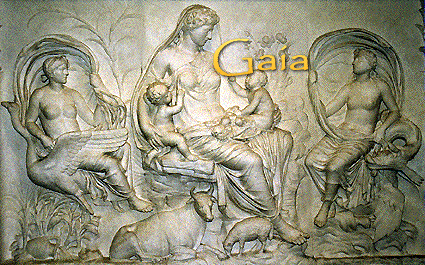
|
| |
|
The
earliest stories of creation in Greek myth tell of how Gaia
was created out of the void. Gaia is earth - Mother Earth.
She was fruitful and gave birth to the mountains, the sea, and the
sky. The sky god Ouranos (Uranus) became her husband and they
became parents of the Titans, a pre-Olympian race who ruled Greece in
the early days. These Titans were much more primitive than their
descendants, but among them was Cronus (Saturn) who would eventually
succeed his father. Ouranos had become a tyrant and
terrorized the Cyclopes, the monstrous offspring of his union with Gaia.
The Earth Mother could not bear to see her children abused in such a way
and implored Cronus to help her put a stop to Ouranos' tyranny.
Armed with a sickle, Cronus cut off Ouranos' genitals and tossed them
into the sea, removing any further generative power from his
father. Cheered by his brothers and sisters, he became the new
ruler. He married his sister Rhea and reigned earth for a thousand
years. However, it was prophesied that Cronus would be overthrown
by one of his own offspring just as he had overthrown his father before
him. Gripped with fear, Cronus began to swallow every child born
to him by Rhea, who like Gaia, was outraged. She then devised a
plan to put an end to this misery. When Zeus (Jupiter) was born,
he was quickly whisked away to a cave on Mt. Ida and replaced by a rock
wrapped in baby blankets. When Rhea presented it to Cronus as the
newborn, he quickly swallowed the rock unaware that it was not a
baby.
Zeus was raised in peace and
prosperity and eventually overthrew Cronus. This lineage of
fathers overtaken by their sons is a basic model of civilization as it
has existed on earth for thousands of years. One dynasty or nation
rules - perhaps for centuries - until the tides change and new
rulers invade and a new order takes over. Usually it happens by
means of war - who has the most weapons, the bigger armies, the largest
treasuries, the most power. And the beat goes on.
Gaia has recently sprung back to
life (1987-1988), fueled by the theory known as the Gaia Hypothesis. Developed
by biologist James Lovelock, it maintains that our planet is a living,
breathing organism, and that each individual act upon the earth is
linked to and has direct consequences for every other part of the
planet. The physical sciences are ruled by Saturn, (biologists
like Lovelock) who are sons of our industrial world
(Uranus). It was the birth of the Industrial Revolution which
coincided with the discovery of the planet Uranus (1781) and which led
us into the age of technology and industry which has characterized our
life on earth for these past two hundred years. While it has
given us tremendous breakthroughs in medicine, food production,
communications, and travel - it has also been the culprit which has
caused so much disease, toxicity, putrefaction of our rivers, streams,
oceans, forests, and wildlife. It is necessary once again to
construct a plan to save Gaia and her children from extinction so that
we may once again enter a Golden Age and live in peace and health for
two thousand years.
It seems the move is on to bring
life on earth back into balance, but as with the birth of any new order,
there is always some last minute resistance - a final attempt to hang
onto old concepts. It is not about going back to the way things
were. We've come too far for that. It is not about women
having sovereignty over men or men being in complete control over
women. Rather, it is a balanced union of male and female as
equals. Whether we are the descendants of the "gods"
from outer space or from the evolutionary process and the apes -
if we think of Gaia as the embodiment of the Earth Mother, and Uranus as
the embodiment of aliens and/or alien technologies (Sky Father) then the
present human race is really a composite of both.
The position of Earth in the
horoscope is always 180° from the Sun. Both points are crucial to
the integration of the self. It is the medium between light and
darkness. A strong Sun without a consciousness of Gaia is divorced
from nature rather than at one with it. Strong links by
planetary aspect to the Sun/Earth polarity will be critical in helping
to define the energy one is working with in life. For
example; if a planet is square to the Sun in a horoscope, it will also
be square to the Earth. It will be the focal point of an
astrological formation known as the "T-square".
Just as the Sun in our charts is
one symbol of father (radiant, creative, spiritual father) - Earth is is
one more form of mother operating innately in our beings.
|
| |
|
|
| |
|

|
| |
|

|
| |
|
|
| |
|
The Asteroids .
. . the archetypal system of
feminine wholeness
|
| |
|
|
| |
|
Along with the discovery of
Uranus (1781) and Neptune (1846), the discovery of
Ceres,
Pallas,
Juno,
and
Vesta, located in the asteroid belt, in 1802 changed the course of
history forever. While the later four bodies were not considered
true planets, Ceres sat precisely where one should - according to Bode's
Law - in the center of the solar system between Mars and Jupiter.
All four were classified as asteroids. Their orbital characteristics
are similar to the larger planets even though they are a great deal
smaller in size.
According to Eleanor Bach who
pioneered the research on the asteroid goddesses and their astrological
significance, Ceres and Vesta (the "working" goddesses) belong
to Virgo, while Pallas Athene and Juno (the "relationship"
goddesses) belong to Libra. One astronomical theory concerning the
asteroid belt is that the thousands of chunks of asteroids floating adrift
in a cosmic sea between Mars and Jupiter were once a whole planet.
Because Jupiter is so large and its gravitational pull so strong, this
planet was pulled into Jupiter's mass and exploded. It is believed
that this planet represented an archetypal system of feminine wholeness -
or at least a significant portion of the feminine, which, like the Goddess
culture of old, was overtaken by masculine sky-gods such as Jupiter.
These floating pieces constitute the various fragments of the feminine
which are seeking reunification.
In myth each of these goddesses were
part of Jupiter's family. Ceres (Demeter), Juno (Hera) and Vesta (Hestia)
were sisters of Zeus and had major roles in the Greek pantheon.
Ceres was the earth goddess in charge of the agriculture cycle. Vesta, the
temple goddess, was in charge of mankind's spiritual center. Juno
and Pallas Athene were Jupiter's wife and favorite daughter. Each of
the four goddesses for whom the original four asteroids were named was one
of the twelve Olympians that were honored and revered throughout the
ancient world. Their inclusion is timely.
The introduction and subsequent
incorporation of these four asteroids into the zodiacal rulership
scheme has eliminated some of the outworn themes of astrology.
|
|
|
|
|
|
|
|
|
|
|
|

|
|
|
|
| |
|
Ceres
(Demeter) was considered the Goddess of the earth and harvest and was
associated with the mysteries of the Eleusis. Even
today it is not possible to be certain about what went on in the telesterion,
the Eleusinian shrine . Despite the fact that the mysteries of
Eleusis persisted for a thousand years, no one ever gave away the
secret.
According to the story, Kore,
the maiden daughter of Demeter, was picking a flower one day when the
earth opened up before her. A dark chariot emerged from the depths,
driven by a dark rider. It was Hades (Pluto), lord of the
underworld. He seized her and carried her unwillingly into the land
of the dead. Triptolemus, the son of the Eleusinian king, had been
herding his father's cattle when Kore's abduction took place and had
witnessed the event. When he told Demeter what had happened to her
beloved daughter, the earth mother went into mourning and in her
depression, forbade the earth to bear fruit until her daughter was
returned. Moved by the prayers of mortals, Zeus sent Hermes into the
underworld to beg for Kore's release. Hades consented as long as
Kore had not yet tasted the food of the dead. However, it was
revealed that Kore had eaten seven pomegranate seeds. A compromise
had to be reached. Kore would spend three months of each year in the
underworld and the remaining nine upon earth. During her absence,
the cold of winter would reign, but while she was above ground, the long
Mediterranean spring and summer would flourish. Still she was now
the dark Lord's queen and thus her name would no longer be Kore the maiden
- but Persephone - "she who is to be feared".
The Ceres and Persephone story
depicts the rite of passage of the loss of innocence and the breaking of
the bond between mother and child. Ceres' position in the
horoscope involves her role as mother and for this reason she can be
associated with the sign of Cancer although the Moon is accepted as the
sign's ruler. However, it is not incorrect to link Ceres with the
sign as well. She is the "earth mother" who carefully and
lovingly gives her child his/her first book to read at bedtime, who
teaches the child to lace his shoes, and who provides the framework for
the child to make its way in the world. Those with Ceres in
prominent positions will identify strongly with their inner earth mother
or, in the charts of men, with the ability to play the role of
"caretaker". If Ceres is involved with the Moon there may
be a strong emotional dependency between mother and child such as Kore and
Demeter shared. Persephone was every thing to her mother and when
the child became separated from Demeter it was if a part of her were lost
and she no longer was able to function in the physical world
performing her work.
The position of Ceres in the
horoscope has a strong connection with food and eating habits, based on
her role as the grain goddess. An afflicted Ceres would result in
one kind of eating disorder or another. Ceres glyph -  - is an upside down and reverse Saturn. It would seem that both have
a lot in common. Both planets have to do with parenting and
both can potentially develop possessive, overbearing, or strangulating
relationships with their children.
- is an upside down and reverse Saturn. It would seem that both have
a lot in common. Both planets have to do with parenting and
both can potentially develop possessive, overbearing, or strangulating
relationships with their children.
|
|
|
|
| |
|

|
| |
|
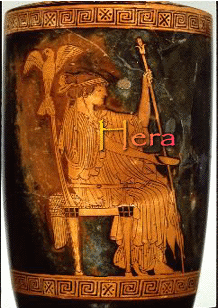 When
the invading Indo-Europeans entered Greece, they found it necessary to
incorporate many of the previously existing religious customs and
rituals into the new system. Many of the gods of the Greeks were
ritually married to one or another aspect of the Goddess in order to
merge the two systems. Thus Hera
was merged with the new ruler of the gods,
Zeus. In the human
social sphere, this corresponds to the custom of arranged marriages,
marriages of convenience in which two powerful families, nations, or
political opponents agree to a political or social alliance by merging
their families and future heirs. This is a tradition that has been
repeated for centuries, especially among royalty and powerful
families. When
the invading Indo-Europeans entered Greece, they found it necessary to
incorporate many of the previously existing religious customs and
rituals into the new system. Many of the gods of the Greeks were
ritually married to one or another aspect of the Goddess in order to
merge the two systems. Thus Hera
was merged with the new ruler of the gods,
Zeus. In the human
social sphere, this corresponds to the custom of arranged marriages,
marriages of convenience in which two powerful families, nations, or
political opponents agree to a political or social alliance by merging
their families and future heirs. This is a tradition that has been
repeated for centuries, especially among royalty and powerful
families.
In addition to being Zeus' wife,
Hera was also his sister, one of the children of Rhea and Cronus
(Saturn). When Zeus (Jupiter) took her as
his wife, he was not simply taking a marriage partner, but incorporating
within his ruling domain the entire matriarchal world, previously headed
by his new bride. Their marriage was stormy and turbulent because of
Zeus' frequent infidelities, Hera's jealous rages, and their mutual
attempts to seek revenge on one another. One may wonder why Jupiter,
who could have had any woman in the world or goddess in the heavens, would
continue this kind of relationship. But were he not married to Hera,
Jupiter would not have been himself, for Hera is the embodiment of
Jupiter's female polarity as Jupiter is the embodiment of Hera's male
side. Her strength and temperament empowered him and vice
versa. Their relationship is a prototype for the importance that
marriage, no matter how turbulent, plays for a highly visible political
leader or monarch.
Hera (Juno)
is the patron goddess of Marriage. She gave birth to two
children - Mars and Vulcan (Hephaestus) - but had no particular affinity for either of
them; thus her role in the horoscope may be that of someone more concerned
with peer relationships that with parent/child relationships. The
Juno/Hera person's love for his or her children is very conditional
. . . they must meet her social expectations to be worthy of parental
affection.
It has been suggested that Hera's position in the horoscope is
related to an individual's marriage potential. But Hera's appearance
in a chart may not be related strictly to marriage; she also represents
the internal emotional rage which develops and combusts when a loved one
has betrayed, deceived, or misused his or her vows of loyalty and
devotion. Another dynamic of the marriage between Hera and Jupiter
illustrates the notorious double standard still evident in
contemporary marriages. Modern day Heras who pine over their
spouses' infidelities but refuse to do anything about it or who
inflict their anger on the spouse's lover rather than the spouse, are
examples of a dysfunctional marriage. Status and wealth are the main considerations
for these Heras and so they hang in and refuse to divorce their spouses.
|
|
|
|
|
|
|
|
|

|
|
|
|
|
|
Perhaps the
most remarkable myth about Pallas Athene is the story of her
birth. It is said that Zeus pursued the Titaness Metis, and
made love to her. She was the original guardian of the planet
Mercury, and her name meant "counsel." She became
pregnant as a result of the affair. At that point, Gaia announced
to her grandson Zeus that the first child of Metis would be a girl, but
if the Titaness were allowed to survive she would in time give birth to
a male child who would supplant Zeus. Like his father Cronus
before him, Zeus took action and swallowed Metis - though she continued
forever after to give "counsel" from within his stomach.
One day, Zeus was walking along the shores of lake Triton in Libya when
he was seized with a raging headache. His son Hephaestus relieved
his pain by the unusual expedient of splitting his head open. Out
leapt gray-eyed Pallas Athene, daughter of Metis, clothed in armor and
giving a great shout.
As a child of the father's brain,
it was natural to associate Athene with the human intellect. But
her roots go much deeper and extend far back into antiquity. One
of her principal attributes is the shield she carries, emblazoned with
the image of the Gorgon Medusa, a fierce female demon with snakes
writhing from her head. Mythologists see an identity between
Athene and this fearsome Lady of the Snakes. There are strong
links between Pallas Athene and the archetype of Pluto. Snakes
played an important role in the secret teachings and mysteries
surrounding life, death, and immortality, and Athene was to the Greeks,
the Goddess of Wisdom. Athene possessed the wisdom not merely of
the intellect, but the instinctual feminine wisdom sacred to the
Goddess. Something of the more primal Athene has survived in the
attribution of the owl to this goddess as her sacred bird. The owl
has always been known as a bird of "wisdom" and yet - we
typically understand this to signify a deep inner knowing or
understanding rather than wisdom of a purely intellectual type.
The picture that has been painted
of Pallas Athene, even in contemporary feminist literature, focuses on
her role as a daughter of the patriarchy, i.e., Zeus' daughter.
She comes closer to Jupiter than any of the other "Big Four"
asteroids. It is also true that Athene cast the deciding vote in
the trial of Orestes - a case involving the question of mother-right
versus father-right. Athene's vote against the mother has been
interpreted as patriarchal bias on her part reflecting as a sign of the
times. Athene is the upholder of laws and justice, and as the
agent of such, reflects the laws currently governing the land.
Thus we can observe that
Pallas Athene's evolution from the primal Snake Goddess, possessor and
protector of "feminine wisdom", to the Greek "daughter of the
patriarchy," to the Roman "goddess of war" - parallels the path for
women though the centuries.
Unlike many of the gods and
goddesses of Olympus, who preferred to be around nectar and ambrosia,
this goddess was far from idle. A person with a strong Pallas
Athene signature in the birth chart may have no idea on how to
relax. Athene was a highly skilled, intelligent, courageous,
inventive, and industrious goddess. We can identify Pallas
Athene's most important function in the birth chart . . . her strategy,
judgment, and wisdom - by assessing her house and sign position.
|
|
|
|
|
|

|
|
|
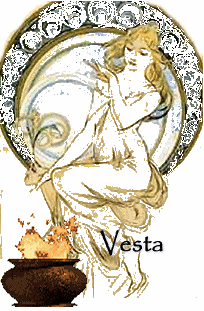 There
are very few personifications of Vesta
in the ancient world. Perhaps this is because she represents an
indwelling spirit, which is hard to personify. In our modern world
it is difficult to imagine what gathering around the family hearth is
like, allowing Vesta's presence to capture our spirits. Today, we
gather around the TV/VCR and it is a totally different experience.
But anyone who has sat outdoors at a campfire or beside their own
fireplace indoors have felt the magic that the fire works upon
them. When one stares into a fire, one may find oneself entering a
trance-like state or at least slightly shifting his/her sensory input
patterns to where the mind becomes more relaxed and calm. Thus
Vesta's invisible presence as the spirit of fire still allows us to
shift our focus into a dreamy, right brain energy. Just as there
are few images of Vesta, there are also few myths about her although the
references that do exist are very revealing. She was the
first-born child of Cronus and Rhea and was the first to be swallowed up
by her father and the last to emerge from his jaws when the
divine children were disgorged back into the world. Thus Vesta is
the alpha and the omega, the beginning and the end. There
are very few personifications of Vesta
in the ancient world. Perhaps this is because she represents an
indwelling spirit, which is hard to personify. In our modern world
it is difficult to imagine what gathering around the family hearth is
like, allowing Vesta's presence to capture our spirits. Today, we
gather around the TV/VCR and it is a totally different experience.
But anyone who has sat outdoors at a campfire or beside their own
fireplace indoors have felt the magic that the fire works upon
them. When one stares into a fire, one may find oneself entering a
trance-like state or at least slightly shifting his/her sensory input
patterns to where the mind becomes more relaxed and calm. Thus
Vesta's invisible presence as the spirit of fire still allows us to
shift our focus into a dreamy, right brain energy. Just as there
are few images of Vesta, there are also few myths about her although the
references that do exist are very revealing. She was the
first-born child of Cronus and Rhea and was the first to be swallowed up
by her father and the last to emerge from his jaws when the
divine children were disgorged back into the world. Thus Vesta is
the alpha and the omega, the beginning and the end.
She vowed to remain eternally
virgin and distanced herself from the quarrels of the gods. It is
from ancient Rome that most of the clues about Vesta are derived.
The ancient goddess of the hearth was assimilated to the Greek Hestia.
In Rome, Vesta's priestesses, the Vestal Virgins, enjoyed a status which
was unique in the ancient world. They not only tended the actual
fire which was the symbolic center of the Roman Empire; they also tended
the inner fire which was the vital spirit of the people. They
reflected the light of the sacred. They were also the keepers of
important wills and public documents. Although they were regarded
as especially sacrosanct, they were also subject to the most bizarre of
penalties. A Vestal Virgin found guilty of breaking her vow of
chastity could be buried alive.
Vesta is the brightest of the
asteroids which is fitting since she was the keeper of the sacred
fire. Prometheus may have stolen that fire from the gods to give
to mankind, but it was Vesta who kept it alive. The
position of Vesta in a chart will show an individual's ability to focus and direct
his or her inner fire towards a specific cause, project, ideal, or
spirituality. Those who lack positive Vesta qualities will tend to
be directionless, unable to define or forge a a path for
themselves. It can also indicate an inability to define boundaries
and indicate a weak immune system. An afflicted Vesta (Mars,
Jupiter, Pluto) may indicate being sexually abused or having a domineering
father (Saturn).
It has been
suggested that Vesta has a Virgo and/or Scorpio rulership. Her
orbital position is nearest to Mars and so she is especially linked to this
planet. Both represent the polarity of sexuality, and both are
prone to problems in that area. Vesta's matriarchal rulership over
the kundalini fire is reminiscent of the the temple prostitutes of the
ancient Near East, while her Graeco-Roman and post-Christian symbolism
is identified with chastity and virginity. Thus she represents a
polarity that has characterized the feminine mystique for over a
thousand years - the "Madonna-Whore" complex which has been a
common male image of women throughout the Christian centuries. To
some men, a woman who does not embody virginal chastity is automatically
a whore - in medieval terms, a consort of the devil. Though this
radical dualism has been absent from our media and literature for the
last three or four decades, it is still a tacit assumption among men
(and women) whose feminine polarity is deeply disturbed.
Observing the two glyphs of Virgo
and Scorpio, it is interesting to note that the two resemble each other
- (Virgo's glyph turns inward representing the ascetic or virginal
polarity, while Scorpio's glyph turns outward, which correlates with the
outward expression of one's sexuality).
|
|
|
|
|
|
|
|
|

|
| |
|
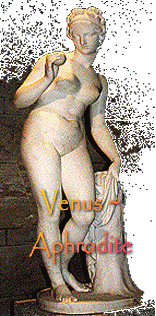 In the beginning the
world was ruled by Uranus, the Sky Father, and Gaia, the Earth Mother -
the primordial pair. Uranus became a tyrant and was overthrown by
his son Saturn, who castrated him with a sickle. The creative seed
of the primal sky god was scattered throughout heaven and earth.
Some of it fell into the ocean and gave birth to Venus, whom the Greeks
knew as Aphrodite, the goddess of love. She rose full-grown from the
sea foam, billowed up by the waves and riding on a sea shell. In the beginning the
world was ruled by Uranus, the Sky Father, and Gaia, the Earth Mother -
the primordial pair. Uranus became a tyrant and was overthrown by
his son Saturn, who castrated him with a sickle. The creative seed
of the primal sky god was scattered throughout heaven and earth.
Some of it fell into the ocean and gave birth to Venus, whom the Greeks
knew as Aphrodite, the goddess of love. She rose full-grown from the
sea foam, billowed up by the waves and riding on a sea shell.
Psychologically, we may say that
the desire for love, sex, and relationship is the first of human
functions to emerge from the ocean of the unconscious symbolized by
Pisces (exaltation of Venus). It is Venus, the goddess of love,
who dances on the waters of the collective mind or world
soul. She emerges from the ocean still clothed in golden light,
smiling with the knowledge of other realms; she is a guide
to the deepest layers of the unconscious. As astrological
ruler of both Taurus and Libra, Venus embodies two principles -
self-worth in Taurus and how much value is derived from the beloved
(Libra). In Libra she is more concerned with the interplay of
opposites that exist within a relationship. In Taurus she exudes
raw sensuality representing the aspect of the goddess whose sole purpose
it is to enjoy the abundant earthiness of the physical world reflected
in nature and the body. As
the goddess of love and beauty, Venus quite logically became the planet
of relationships since she is the traditional ruler of the sign
Libra. For a long time, Venus has been erroneously associated with
marriage in the horoscope. However, with the addition of the four
major asteroids, the proper functions were restored to the proper
goddesses. While Venus has associations to love and romance, she
is not at all fond of marriage. Yet, in examining the myth of
Venus we find that she was indeed married to Hephaestus who she rejected
and humiliated constantly. While married to him, she engaged in an
ongoing love affair with Mars. It is these two planets, Venus and
Mars, that many astrologers use to assess an individual's relationship
needs (Aries and Libra respectively). While the relationship
between the two planets indicates an intense sexual and romantic
attraction, they do not promise a long-term compatibility necessary
for a marriage. Although
Venus is beautiful and lovely, easily the most beautiful of the
goddesses, she must be constantly assured that this is so.
She is a fierce competitor to any woman whose beauty rivals hers and at these times, she reveals her jealous angry side. |
|
|

|
|
|
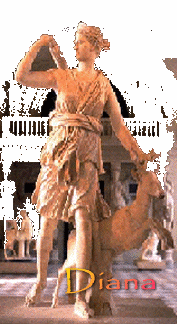 The Moon was
worshipped under a multiplicity of names. However, the most
classical goddess associated with the Moon is Artemis but the Romans
named this deity Diana, an essentially lunar goddess. However,
Artemis-Diana represents the nymph or maiden phase of the lunar cycle; she
is a young woman's goddess, not yet a mother, and her bow is a symbol of
the crescent moon. Because water
is symbolic of the feeling function, and because the Moon has a strong
influence over the tides, it is natural to associate it with
feelings. This in itself places the Moon primarily in a feminine
mode. The mean period of the Moon's revolution is
twenty-eight-and-a-half days, which links it closely with the menstrual
cycle. In ancient times, the Great Goddess was perceived in terms
of phases; despite her many names, she had three principle
aspects. In the beginning, she was the nymph or maiden,
corresponding to the crescent Moon. As the full Moon, the Goddess
manifested as the mother, her belly as round as the Moon at full.
As the waning Moon, the Goddess manifested as the crone or wise old
woman. The Moon was
worshipped under a multiplicity of names. However, the most
classical goddess associated with the Moon is Artemis but the Romans
named this deity Diana, an essentially lunar goddess. However,
Artemis-Diana represents the nymph or maiden phase of the lunar cycle; she
is a young woman's goddess, not yet a mother, and her bow is a symbol of
the crescent moon. Because water
is symbolic of the feeling function, and because the Moon has a strong
influence over the tides, it is natural to associate it with
feelings. This in itself places the Moon primarily in a feminine
mode. The mean period of the Moon's revolution is
twenty-eight-and-a-half days, which links it closely with the menstrual
cycle. In ancient times, the Great Goddess was perceived in terms
of phases; despite her many names, she had three principle
aspects. In the beginning, she was the nymph or maiden,
corresponding to the crescent Moon. As the full Moon, the Goddess
manifested as the mother, her belly as round as the Moon at full.
As the waning Moon, the Goddess manifested as the crone or wise old
woman.
The Moon was worshipped under a
multiplicity of names and there is scarcely a goddess in the entire
pantheon of the Greeks or Celts who does not possess a lunar aspect or
manifestation of some kind. It is difficult to to find any one
goddess who represents the entire range of lunar symbolism.
Although the classical goddess most often associated with Moon is
Artemis, the Greeks regarded her primarily as the Lady of Wild Beasts
rather than the Moon. It was the Romans who made this deity ,
under her Latin name Diana, an essentially lunar goddess.
In an astrological chart, the Moon
functions primarily as a receptacle - like the cauldron of the goddess
which became in medieval legend, the Holy Grail. Everything we
remember, everything we have experienced, is stored in the cauldron of
the Goddess. Is it any wonder that the Moon has traditionally been
associated with memory?
Throughout history, the Moon has been of more
symbolic importance than the Sun. It is the female principle that
plays the aggressive role; the Moon pursues the Sun. Symbolically,
it is emotion (Moon) that triggers and encourages our ego urges (Sun).
|
|
|
|
|
|
|
|
|

|
|
|
|
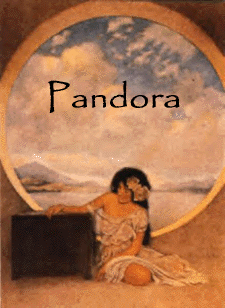 In
modern Astrology, the newly discovered (1781) planet Uranus rules
Aquarius. Uranus, which shatters old and outmoded concepts, is said
to create a turmoil in our lives when it transits something
important. Under Uranus, Prometheus is perhaps the most fitting
archetype for this sign. However, like
Prometheus,
Pandora is another archetype for Aquarius. It was
Prometheus's action of stealing fire and giving it to mortals that angered
Zeus. As a consequence, Zeus instructed the smith-god Hephaestus to
create a special box that he gave to Pandora. Although he told her not to open the box, Zeus felt sure
that she would ignore his command and thus her disobedience would unleash the ills
upon mankind that he placed in the box. The truth of the matter is,
he had set Pandora up to do his dirty work. In
modern Astrology, the newly discovered (1781) planet Uranus rules
Aquarius. Uranus, which shatters old and outmoded concepts, is said
to create a turmoil in our lives when it transits something
important. Under Uranus, Prometheus is perhaps the most fitting
archetype for this sign. However, like
Prometheus,
Pandora is another archetype for Aquarius. It was
Prometheus's action of stealing fire and giving it to mortals that angered
Zeus. As a consequence, Zeus instructed the smith-god Hephaestus to
create a special box that he gave to Pandora. Although he told her not to open the box, Zeus felt sure
that she would ignore his command and thus her disobedience would unleash the ills
upon mankind that he placed in the box. The truth of the matter is,
he had set Pandora up to do his dirty work.
Fair to say, it was more than just
idle curiosity that caused her to open the box. The sealed box was a
place of darkness, fear, and ignorance. Its opening represented
illumination and knowledge (Uranus). But when Pandora opened the box, out came
all the ills and pestilence of the world inflicted by the gods on
humanity. However, in a moment of compassion, Zeus also supplied delusive hope to
prevent men from killing themselves in despair and escaping the full
impact of suffering their Heavenly Father intended for them. The
basic theme is also familiar in the myth of Eve.
Pandora's Vase became Pandora's Box
only in the late medieval period, when Erasmus mistakenly translated pithos
as pyxis. The word pithos describes a honey-vase. Thus
Pandora also poured out blessings from the vessel; a womb symbol like the
Cornucopia, anciently used as a vessel of death and rebirth. It was
symbolic of humanity's hopefulness that knowledge and illumination would eventually cast out darkness, fear, and ignorance and is the
prime ingredient in healing or transmuting all the ills, whether
god-inflicted or man-made.
According to
another myth, Pandora
was the first woman to be personified in an anti-feminist fable by
Hesiod, who tried to blame war, death, disease, and all other ills on
women. Instead of the myth explained above, his myth claimed
that Zeus sent Pandora to earth to punish those men who had offended him.
Hesiod's
story was further adapted to the legend of King Solomon, who was said to
keep a horde of demons in a vase. After his death, greedy men broke
the vase in seeking treasure and let the demons out into the world.
An
erroneous myth can be created to imply a false and unfair account of the
true meaning behind the original and sacred myth.
Hesiod's false account of the Pandora myth is similar to the misleading
myth of Mary Magdalene who has been unfairly portrayed as a prostitute by
the patriarchal leaders of the church instead of one of Jesus' most
devoted disciple and perhaps his wife.
Once
someone or something has been labeled, it is very difficult to reverse the
impact it was intended to make. Unfortunately, this occurs frequently -
with a medical or psychological diagnosis, a projected character trait in someone, a
misunderstanding
of motivation, a false accusation, etc. The Pandora myth reflects human nature when it
is lacking integrity and is an excellent example of why we should not jump
to conclusions about someone or something. We should always try to
discern the motivation behind the "labeling" and discriminate
what is truth from what is someone's endeavor to justify their
vindictiveness, prejudice and/or ignorance. It is each person's
responsibility to avail himself of the truth before accepting another's
myth.
|
|
|
|
|
|
|
|
|

|
|
|
|
|
|
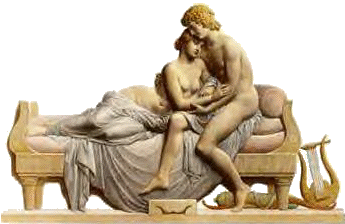
|
|
|
|
|
|
|
|
|
|
|
|
|